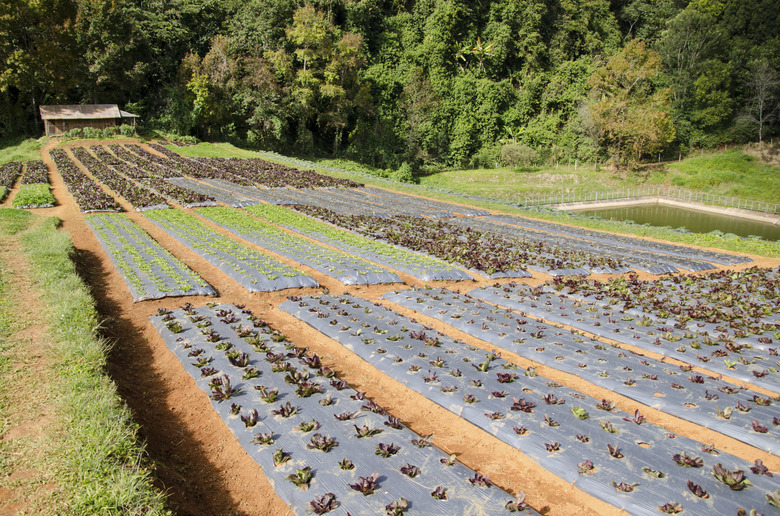Landscape Fabric Vs. Plastic
We may receive a commission on purchases made from links.
In the fight against weeds, landscape fabric and plastic sheeting have staunch advocates. These barrier methods create inhospitable conditions for weeds, yet neither material is foolproof. Their uses go beyond weed control, and each material has advantages and drawbacks. Whether to use landscape fabric or plastic depends on growing conditions and what you're growing.
Weed Control Pros and Cons
Weed Control Pros and Cons
Landscape fabric and plastic reduce the labor involved in weeding, and they reduce the need for toxic herbicides. Both of these inorganic options have limitations and drawbacks, though. In addition to the time and labor for installation and removal, disposal of plastic sheeting and synthetic fabrics can be costly. Due to the bulk of the materials, particularly for large gardens and extensive landscape use, it's often necessary to haul the used ones to the dump.
Also, using either of them in planting areas requires cutting holes or slits to accommodate each plant, and these holes can offer easy access to weeds. And while plastic can smother existing weeds, it's necessary to remove weeds before laying a weed barrier.
Plastic Mulch Pros and Cons
Plastic Mulch Pros and Cons
Plastic sheeting for weed control offers the advantage of being impermeable. It's generally more difficult for weed roots to penetrate plastic than fabric. Black sheeting, commonly used in landscaping and commercial vegetable production, deprives weeds of light as well as moisture. It also helps warm the soil for early planting. It's commonly used with drip irrigation for growing vegetables and small fruit plants to reduce evaporation.
Plastic helps control insect pests and promotes earlier maturation and greater crop yields, according to Penn State Extension. A downside for home use is that plastic reduces oxygen to the roots of trees and other landscape plants, and if used over a large area it can block too much water from getting to plant roots. Plastic sheeting traps moisture in the soil and this can cause tree roots to rot.
Landscape Fabric Pros and Cons
Landscape Fabric Pros and Cons
Although more expensive than plastic, landscape fabric breathes, allowing oxygen and moisture to circulate and water to pass through. This makes it a better choice than plastic for use near trees and shrubs. It's also better suited than plastic for extensive landscape or garden areas if you don't have drip irrigation or a wide planting bed for alternating plastic with bare soil. Landscape fabrics, also called geotextiles, allow water from rain, a sprinkler or hand watering to reach your plants' roots better than uninterrupted expanses of plastic sheeting.
Landscape fabrics are usually synthetic, made from polyester or polypropylene. Biodegradable landscape fabrics create less waste and spare you the work of having to remove them and haul them away, and they are more eco-friendly than plastic. If you use organic mulch over biodegradable landscape fabric, the organic mulch will enrich the soil instead of being blocked as it would be by plastic.
Choosing and Using a Barrier
Choosing and Using a Barrier
For cool locations, clear plastic allows greater soil warming but doesn't deter weeds or pests as well as black plastic. Landscape fabrics that suppress weeds the best tend to have the smallest pores.
To choose between fabrics for the greatest weed control, hold them up to the light. The smallest pores allow the least light through. A layer of mulch improves the appearance of landscape fabric or plastic sheeting and can slow the breakdown of the materials by blocking sunlight. If you use an organic mulch such as bark, limit the mulch covering to 1 inch deep to deter weeds from rooting in it.
